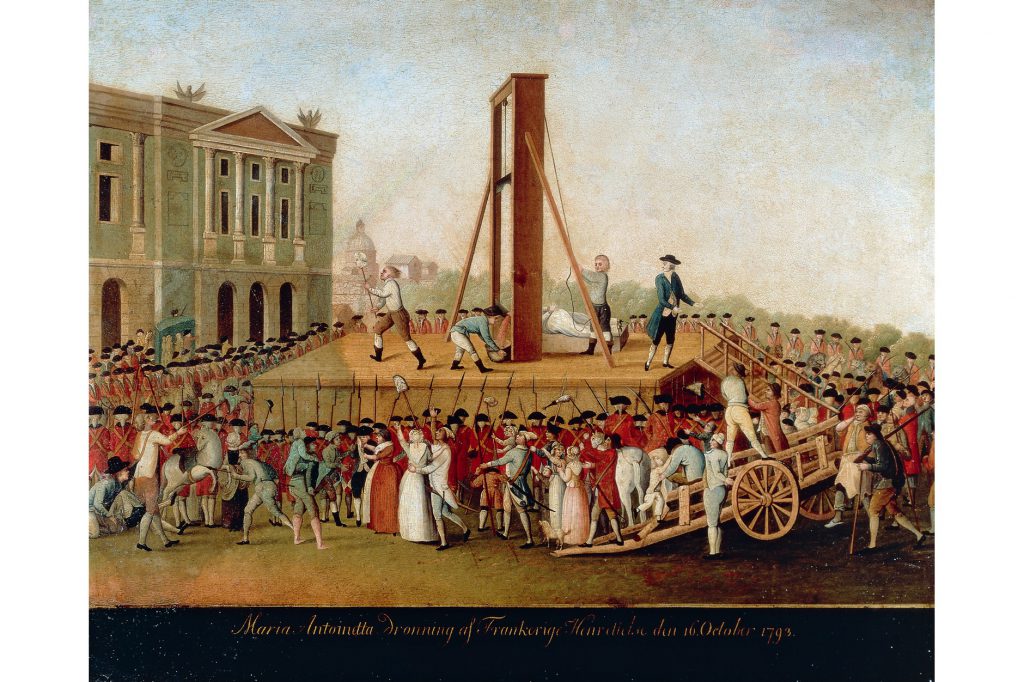
Two and a half months before her execution, at two in the morning, the Queen along with her daughter and sister-in-law were suddenly awakened and informed that the Queen was to be transported to the prison of Conciergerie. Without protest, Marie Antoinette got dressed and bid farewell to her family members. Then, without looking back, she left the temple. Fifteen minutes later, the Queen arrived in front of the grim towers of the Conciergerie, where she was registered under the name of “The Widow Capet” and became its 280th prisoner.5 She was led by the jailers to her new quarters. It was a dungeon of fifteen square meters with walls covered with an old cloth stained by humidity. It also had a narrow window at ground level that let in a pale light. Her only furniture consisted of a camp bed, two straw seat chairs, a convenience chair, and a bidet. Only a screen shielded her from the gaze of her guards and gave her no privacy at all. An assigned maid did everything she could to improve the Queen’s conditions during captivity.6

Alexander de Rougeville was loyal to the Republic at the beginning of the revolution; however, after he witnessed the Queen’s misfortune, he decided to help her to freedom. He had formerly been part of the Comte de Provence’s military establishment and was one of the officers who had protected her on June 20, 1792. That day, angry mobs broke into the Tuileries and forced the King to acknowledge the Republic. In addition, Marie Antoinette was insulted and called a traitor of France. In early September, he accompanied the royal family’s jail administrator Jean-Baptiste Michonis to the Conciergerie with two carnations pinned to his lapel. A plan called the Carnation Plot was attempted to aid the Queen to flee the country. Marie Antoinette picked up the flower and inside, the petal concealed a tiny note, which the Queen attempted to answer by pricking out a message with a pin. However, the gendarme on duty noticed her actions, took the incriminating evidence, and gave it to his immediate superiors. The name of the plot was taken from a flower that a certain Rougeville dropped at the Queen’s feet in her cell. The idea was for Marie Antoinette to escape to the château of Madame de Jarjayes. She was the Queen’s lady in waiting and her husband was General de Jarjayes, a loyal follower of the royal family. The Queen would then be transported to Germany, which was under the rule of Austria, Marie Antoinette’s homeland. The plot failed, but before the Republic could send the guards to capture him, Rougeville managed to escape.7
In the former Grand Hambre of the Palais de Justice, the Queen of France appeared before the Revolutionary Tribunal dressed in black and wore a widow’s bonnet in white lawn and trimmed with black mourning crepe. The Republic gave her lawyers less than a day to prepare a defense. One of the accusations against her was that she had been one of the instigators of the Champ-de-Mars massacre of July 1791, and that she had sent money out of the country to her brother, the Holy Roman Emperor. In addition, she was accused of scandalous conduct with her son, and that she had instigated most of the crimes that Louis XVI had committed. Marie Antoinette refused to respond to any charges. However, Marie Antoinette believed that she was innocent of these crimes and did everything within her power to save the monarchy as she conceived it. The entire trial started from October 15, 1793 at eight in the morning and ended on October 16 at four-thirty in the morning.8

On October 16, 1793, at four-thirty in the morning, Marie Antoinette was declared guilty of the three main charges of having secret agreements with foreign powers, of shipping money aboard to Austria, and of conspiring with these powers against the security of French. After ten weeks in the Conciergerie, the Queen’s incarceration came to an end. She was sentenced to death by guillotine and yet she remained impassive and simply shook her head at the verdict. As stated by Chauveau-Lagarde, Marie Antoinette showed true courage and was void of any negative emotion.9 Once returned to her cell, the Queen wrote a farewell letter to Madame Elisabeth, her sister-in-law. During the preparation for her execution, Rosalie witnessed the planned humiliation carried out on Marie Antoinette. First, she was obliged to prepare herself under the gendarmes’ watchful eyes. When she attempted to undress in a little niche between the wall and the bed, she signed to Rosalie to shield her. However, one of the men came around and stared at her. The humiliation continued when Charles Henri Sanson came and hacked off her thin white hair with enormous scissors. Marie Antoinette was also told her hands must be bound, even though the late Louis XVI hadn’t had his hands bounded. The next humiliation occurred when she was overcome with weakness and asked to have her hands unbound and squatted in the corner. Having relieved herself, she meekly held out her hands to have them bound again.10
The day was fine and slightly misty, as huge crowds lined the route to the Place du Carrousel’s guillotine and listened to the cries of the escort: “Make way for the Austrian woman!” and “Long live the Republic!”11 Mainly the crowd heard these cries with satisfaction. By the time the cart reached the Place du Carrousel, she was sufficiently in command of herself to step down easily. Stepping lightly “with bravado,” she sprung up the scaffold steps despite her bound hands, and paused only to apologize to her executioner for stepping on his foot.12 So she went willingly, even eagerly, to her death. The head of Marie Antoinette, desired by the leaders of the French Revolution, was cut off cleanly at 12:15 on Wednesday, October 16, 1793, and was exhibited to a joyous public.
On the very day of the execution, the Queen’s mutilated body was taken to the small cemetery of the Madeleine, where the King’s body had been left nine months earlier. On November 1, a gravedigger buried the Queen’s remains and sent the following note to the multiple authorities. “The widow Capet. 6 livres for the coffin. 15 livres, 35 sols for the grave and the gravedigger.” These words described the funeral of the last Queen of France.13 With the restoration of the monarchy, on January 18, 1815, the remains of the royal bodies were exhumed with the help of Pierre Louis Desclozeaux, an old lawyer who lived at 48 rue d’Anjou. He remembered the two interments and had subsequently tended the sites. He created a garden out of the area and planted two weeping willows as a commemoration. The bodies were then briefly held at the house in the rue d’Anjou. Prayers were said before they were sealed in new coffins with appropriate inscriptions of the majesty and titles of the occupants. On January 21, 1815, a formal procession led the coffins to the Saint Denis cathedral.14 Commemorative statues of Louis XVI and Marie Antoinette were built in the cathedral and their remains were reburied in the Bourbon vault.15
No longer considered one of history’s greatest criminals, the last Queen of France today arouses interest and compassion. After her death on the scaffold, Marie Antoinette entered the world of legend and became a mythical figure.16 Being a scapegoat for the revolution, the Republic’s political decision for her execution united France. Despite being a sacrifice for the French, she never lost her composure and retained her image as a dignified Queen until the last moment of her life.17
- Evelyne Lever, Marie Antoinette: The Last Queen of France (NY: Farrar, Straus and Giroux, 2000), 304-305. ↵
- Evelyne Lever, Marie Antoinette: The Last Queen of France (NY: Farrar, Straus and Giroux, 2000), 213. ↵
- Evelyne Lever, Marie Antoinette: The Last Queen of France (NY: Farrar, Straus and Giroux, 2000), 250-259. ↵
- Evelyne Lever, Marie Antoinette: The Last Queen of France (NY: Farrar, Straus and Giroux, 2000), 287-290. ↵
- Evelyne Lever, Marie Antoinette: The Last Queen of France (NY: Farrar, Straus and Giroux, 2000), 291-292. ↵
- Evelyne Lever, Marie Antoinette: The Last Queen of France (NY: Farrar, Straus and Giroux, 2000), 292. ↵
- Evelyne Lever, Marie Antoinette: The Last Queen of France (NY: Farrar, Straus and Giroux, 2000), 293-294. ↵
- Evelyne Lever, Marie Antoinette: The Last Queen of France (NY: Farrar, Straus and Giroux, 2000), 299-304. ↵
- Antonia Frazer, Marie Antoinette: The Journey (NY: Doubleday, 2001), 435-438. ↵
- Antonia Frazer, Marie Antoinette: The Journey (NY: Doubleday, 2001), 438-440. ↵
- Antonia Frazer, Marie Antoinette: The Journey (NY: Doubleday, 2001), 439. ↵
- Antonia Frazer, Marie Antoinette: The Journey (NY: Doubleday, 2001), 440. ↵
- Evelyne Lever, Marie Antoinette: The Last Queen of France (NY: Farrar, Straus and Giroux, 2000), 305. ↵
- Antonia Frazer, Marie Antoinette: The Journey (NY: Doubleday, 2001), 447. ↵
- Antonia Frazer, Marie Antoinette: The Journey (NY: Doubleday, 2001), 457. ↵
- Evelyne Lever, Marie Antoinette: The Last Queen of France (NY: Farrar, Straus and Giroux, 2000), 308-309. ↵
- Antonia Frazer, Marie Antoinette: The Journey (NY: Doubleday, 2001), 453. ↵




80 comments
Aurora Torres
I have read about Maria Antoinette, even watched movies about her. But I honestly never knew what her true crime was and why the whole Royal family was executed. But from your article I understand why. It is crazy to read that people still respected her as a Queen and wanted to help her escape but was caught. I believe she went out as a true Queen and did not try to out talk herself from being executed. She was very brave and died with so much honor.
Madison Goza
Your article was such a fascinating read! I liked how you opened your article with Marie Antoinette’s questioning of what led her to this moment of her death; your introduction drew me in, and I wanted to learn more. I appreciated how you set the stage for the French Revolution and the context for her execution. Your use of descriptive language also made the details of her imprisonment come alive. Overall, I think your writing was very strong and straightforward, and you emphasized throughout the article that she approached her death with dignity. Well done!
Madeline Chandler
Such an informative and interesting article! Very captivating. Honestly, I am familiar with the story of Marie Antoinette yet not in this much detail. I am fascinated with French history because my family is French. It is so unfortunate that false allegation costing her life was the excuse for the French Revolution. It was very intriguing to be that she could have been saved if the crowd did not recognize her family. I loved reading your article. Great job!
Christopher Metta Bexar
I’ve always been curious about Marie Antoinette. Like Catherine of Aragon she was the daughter of one of the most capable European monarchs, the Empress Maria Therese ( her mother was the Hapburg Empress by birth not marriage).
I had read some of the legends, and like Catherine of Aragon I’d always expected Marie Antoinette to be like her mother . It might be said that both of them were married off to men who were not their intellectual equal.
Marie Antoinette I’ve always read was dignified and remembered her station in life. The article illustrates that she was b0rn a princess and determined to live her entire life behaving in a manner suitable to her upbringing.
Robert Thornton
Marie Antoinette was not the last Queen of France. Have you forgotten the Restoration?
Sara Alvirde
Such humility and harshness to the Queen is very tragic even if it wasn’t for the Revolution, she was given so much negativity as a Queen which was due to her nation being in such a hard time and had never been a favorite of her people. I find it so sad that the Queen had no time either to justify herself I mean it really shows how unfairly the people and authorities were to her not giving her a second chance!
Paula Salinas Gonzalez
I totally loved this article! It honestly has been one of my favorites. It is very well written and the story flows so well. I think that Marie Antoinette’s story is very tragic. Even if it was for the revolution, I don’t think that the humiliation prior to her death was necessary. Like the article said, she was just a scapegoat and the people revolting took their anger out on her, when in fact, bad things had been already occurring before. I think that towards the end, Marie Antoinette accepted her fate and chose to die as a queen with dignity and poise, different from how everyone started to treat her.
Carlos Cortes
Great job on your article!! It was a story that I had learned about in history class but one that was never really interesting too. And now after reading the article it made me want to learn more and even find out what legends are out there of her. And maybe try to even get more information about her and her legacy.
Seth Roen
I find that Marie Antoinette is a tragic character in history. She had the misfortune of being the queen of a struggling nation. Marie Antoinette was never a popular queen, and rumors were spreading since her marriage to Louis XVI. You also can pity her during her trait that did not seem fair trait, with her lawyers only having an hour to prepare her case.
Shanita Frazier
I thought this was a great article. I believe that she was not innocent of crimes against the revolution because she already had a secret plan to flee the county but then she got recognized by the National Guards and she got escorted back to Paris. So, if she is secretly planning things and not able to be seen in the public that says to me that she in definitely not innocent. I find it interesting to learn how some problems were handled before vs now, I also really like how she kept her composure during the whole process. Very Good!